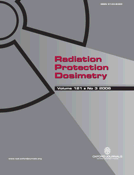-
Views
-
Cite
Cite
S. Park, J. K. Lee, C. Lee, Development of a korean adult male computational phantom for internal dosimetry calculation, Radiation Protection Dosimetry, Volume 121, Issue 3, December 2006, Pages 257–264, https://doi.org/10.1093/rpd/ncl042
Close - Share Icon Share
Abstract
A Korean adult male computational phantom was constructed based on the current anthropometric and organ volume data of Korean average adult male, and was applied to calculate internal photon dosimetry data. The stylised models of external body, skeleton, and a total of 13 internal organs (brain, gall bladder, heart, kidneys, liver, lungs, pancreas, spleen, stomach, testes, thymus, thyroid and urinary bladder) were redesigned based on the Oak Ridge National Laboratory (ORNL) adult phantom. The height of trunk of the Korean phantom was 8.6% less than that of the ORNL adult phantom, and the volumes of all organs decreased up to 65% (pancreas) except for brain, gall bladder wall and thymus. Specific absorbed fraction (SAF) was calculated using the Korean phantom and Monte Carlo code, and compared with those from the ORNL adult phantom. The SAF of organs in the Korean phantom was overall higher than that from the ORNL adult phantom. This was caused by the smaller organ volume and the shorter inter-organ distance in the Korean phantom. The self SAF was dominantly affected by the difference in organ volume, and the SAF for different source and target organs was more affected by the inter-organ distance than by the organ volume difference. The SAFs of the Korean stylised phantom differ from those of the ORNL phantom by 10–180%. The comparison study of internal dosimetry will be extended to tomographic phantom and electron source in the future.



